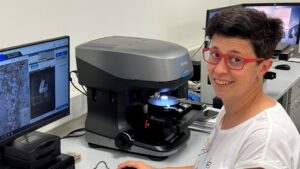A new look at printed parts
Additive technologies, sometimes simplified to 3d printing, are nowadays reaching many fields and working with different materials. In addition to conventional plastics, metal parts produced using these technologies are also making a significant impact. How to print them correctly and how to handle them well are some of the basic questions we are currently addressing with our partners in the cross-border AM SURF project.
„Every operation on a metal part leaves marks on it and they are not always desirable. Just as a welder will tell you that no weld is best from the point of view of the quality of the construction, we are trying to find the right procedure for the production of these parts to reduce the need for further work on it,” describes the basic motivation in the project, the head of the research team, Ms. Martina Koukolíková (COMTES FHT).
Many industries work with metal printing today, from toolmakers to medical fields. Each application has its own specific requirements for the material properties of the finished parts. The surface itself plays an important role for further processing and use. This is what the researchers in the AM SURF project will focus on. Each of the three participating research organisations will bring its unique know-how. The technology centre in Cham, Bavaria, will print test samples according to set criteria. Researchers from OTH Amber-Weiden will then treat part of the surface with a special laser to achieve the desired properties. During the project, COMTES FHT and its material analysis experts will examine the properties of the printed and modified parts and help determine more suitable criteria for production.
In order to ensure that the project does not remain only on the theoretical level, Klastr Mechatronika is also involved in the project, as it has good links to the specific users of these technologies and thus guarantees that the results of the research team will reach the companies and users who will apply them. “The great thing about additive manufacturing is its adaptability to different sectors. Currently, medical materials are being tested that facilitate healing by their surface, which is important for various implants, for example. You want your “new hip” to work as soon as possible,” says Kateřina Podaná from Klastr Mechatronika, describing the advantages of printed materials: “on the other hand, if you are a toolmaker and you want to coat drill bits, you want to have a high-quality, smooth surface that will guarantee the durability of the coating you add.”
Describing the properties of metallic materials in additive manufacturing is not easy. The technology itself will of course affect the properties of conventional materials, which are generally known. In addition, these technologies make it possible to make parts from several different materials and thus affect some parts of the final piece. COMTES FHT will use the new confocal microscope acquired thanks to the AM SURF project to investigate the surface properties of printed parts. “This type of microscope combines the advantages of classical approaches. It uses different combinations of lasers to offer us different types of images, such as surface profile, surface roughness and so on,” says Mr. Pavel Podaný, Head of Materials Analysis at COMTES FHT, summarising the advantages of this equipment. “Simply put, we can analyse several things on one device, find printing errors, for example, and suggest parameter adjustments for printing and subsequent processing. Our goal is to reduce the need for subsequent operations and therefore the intervention in material properties as much as possible,” adds Ms. Koukolíková, referring to the mention of welds.
The AM SURF project is supported by the European Union under the Interreg Bavaria-Czech Republic programme. In addition to the research activities themselves, the project also includes various public events during which the research team will share its results with the professional and wider public. The next of these events is planned for spring 2024.
About project partners:
COMTES FHT a.s. has extensive experience with national and international research projects from various research programmes. During its existence (founded in 2000) it has solved or has solved more than 150 research projects. The company’s top experts have been involved in additive manufacturing since 2017.
Ostbayrische Technische Hochschule Amberg-Weiden (OTH), a young and dynamic institution in Upper Palatinate, has been closely linked to regional SMEs and local global corporations since its establishment in 1994. The internationalisation strategy focuses on cooperation with Czech partners. This has led to a large number of successfully implemented academic and scientific projects. In order to further strengthen these activities, a Competence Centre for Central and Eastern Europe was established in 2018.
Technologické centrum Cham (TCC) has been successfully working in the field of research and development since 2010. These include control technology, simulation of mechatronic components, handling technology, drive technology and additive manufacturing. TC Cham focuses in particular on collaborating with industrial partners to establish high-level basic research. The TCC team consists of mechanical, electrical and mechatronic engineers who have gained extensive experience in the described environment in current and completed projects.
Klastr MECHATRONIKA specializes in connecting the corporate and academic sectors, both locally or nationally and across borders. The Cluster has long been cooperating with important actors on the Czech and Bavarian side. Since 2019, the Czech Technology Platform for Additive Manufacturing has also been operating as an organizational unit within KM, through which KM works closely with other platforms and organizations across Europe. For knowledge and technology transfer, KM has developed and tested its own concept of networking events in past projects, which work well in building functional networks. The cluster currently works with a wide network of companies and other organisations on the Czech and Bavarian side.

